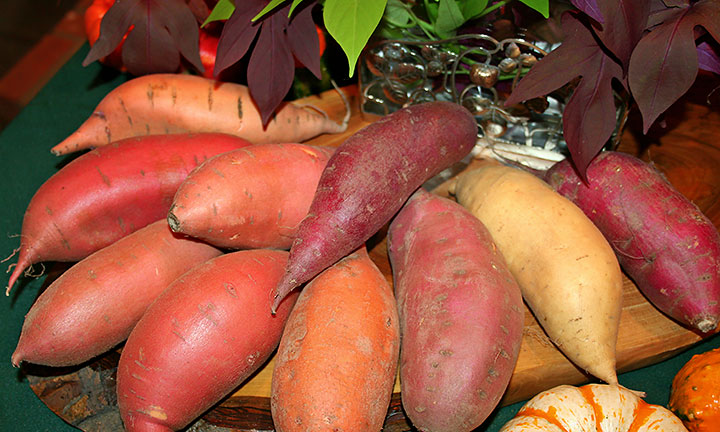Discovering Shochu: Episode 4 – Imo Shochu (sweet potato)
The last three DISCOVERING SHOCHU articles have touched upon all ingredient types. The next few episodes will focus on each Shochu type, delving deeper into the history, characteristics, food pairings, and serving suggestions. The first focus will feature Imo Shochu (sweet potato shochu).
Alike all potato families, Kansho sweet potatoes were said to have originated in the Peruvian tropics of South America. They crossed the Pacific to Southeast Asia via Spanish and Portuguese explorers, and then spread into China. In the 17th century, Ryukyu emissaries to China returned with gifts including Kansho sweet potatoes. Called Karaimo in Okinawa, they entered Okinawa, Japan in 1605 during the early reign by Sokan Noguni of Ryukyuin.
During the next 100 years, the plant spread to Satsuma which is present day Kagoshima Prefecture in Kyushu, where they came to be called Karaimo. When the sweet potatoes reached the Amami Islands, the name changed to Satsumaimo, or “Satsuma potatoes”, because Amami was a territory of the Satsuma stronghold. Trailing rice and grains, sweet potatoes became a popular base ingredient for Shochu in the mid 1700’s.
Kansho sweet potatoes belong to the perennial morning glory family. In the old days, the edible tuberous root was used whole, steamed, and with the skin left intact. Modern day breweries have made great advancements with innovative technology to improve their brew. Some peel the potatoes, steam them, or grill them before brewing. Aside from the conventional white Koji (Aspergillus Kawachi), some use the unconventional yellow and Kuro Koji. There’s now the new decompression method, where brewing occurs in an air vacuumed environment. With so many variables, from Koji types to new methods in steaming and distilling, breweries are now able to create Shochu beyond the traditional brew, with unique aromas, mouth feels, and tail that suit modern cuisines and lifestyles.
SWEET POTATO TYPES
Today, there are upwards of 40 potato types being used for making Shochu. Similar to grapes in wine, breweries strive to highlight the best attributes of a specific sweet potato type, to be delivered with each sip. Breweries distinguish themselves from others by establishing a hold as specialists within a certain ingredient type or production method. The three most popular sweet potatoes specifically used for Shochu production include the following:
Koganesengan
This variety was born in 1966 in Kyushu, and is the most popular sweet potato in Kagoshima Prefecture. It’s a very starch-rich crop, very sweet, and is delicious to eat. Shochu made with refined Koganesengan has the fragrance of chestnuts.
Joywhite
JoyWhite was the first Japanese sweet potato specifically created for Shochu production. Introduced in Kyushu in 1994, the name appropriately reflects its light skin and white pulp nature. The unique, not-too-excessive starch quality produces an elegant-smooth finish and a fruity-citrus aroma.
Beniazuma
Beniazuma is an early creation, born in 1984 in Ibaragi Prefecture located in central Honshu. It’s a strong plant, fast-growing with an abundant yield. When baked, it becomes a sweet and delicious treat. Beniazuma produces a rich and sweet Shochu, characterized by a silky sweetness that expands in your mouth.
WHAT MAKES A GREAT IMO SHOCHU?
Potatoes are a universally economical agricultural crop. However, when it comes to their incorporation as ingredients for Shochu making, they must meet certain conditions. Breweries inspect shipments of raw materials carefully using the following check points:
(1.) Potatoes Must Be Fresh. Shochu making requires freshly harvested potatoes. Once out of the soil, potatoes are prone to diseases especially in temperatures above 68 degrees Fahrenheit (20C), plus they germinate quickly which causes them to consume their own starch. Sweet potatoes harvested in low temperatures are also undesirable because of their rotting smell undertones.
(2.) Scarring & Bruised Portions Must Be Removed. Bruised and scarred areas harbor high bacteria. Exposed flesh secrete substances which emit a foul smelling, bitter flavor. All damaged portions are carefully removed before processing.
(3.) Suitably Sized. Large sized potatoes cannot be steamed or grilled to the core sufficiently, and lead to added tasks thus lowering work efficiency. It’s ideal to work with uniformly sized potatoes.
(4.) Must be Pest-Free. For obvious reasons, pests and mold growths are undesirable. These can damage the flavor by brining out the bitter tones.
(5.) High Starch Content RULES! Quality of Shochu sweet potatoes is determined by the level of starch contained in the root. The greater the starch content, the higher the quality, thus destined for great Shochu brewing.
HOW TO BEST ENJOY IMO SHOCHU
1. For hot Shochu, use very hot water, a step short of boiling, about 160 to 175 degrees Fahrenheit (70˚C – 80˚C). Store Shochu at room temperature. Pour in a ratio of 6 parts Shochu to 4 parts hot water, or 5:5 for a milder mix. ALWAYS pour hot water first, to temper the cup, and also to reduce the water’s temperature. Add Shochu last, aiming for an ideal mixed temperature of 100 to 115 degrees Fahrenheit (40˚C – 45˚C). Adding Shochu to very hot water will dissipate or damage the delicate flavor nuances, and cause bitterness to rise.
2. Mixing a perfect glass of hot Shochu takes practice. Therefore, rather than chance ruining the gorgeous fragrances and delicate flavor through introducing heat, serving cold would be an easier process. On the rocks or with cold water is recommended to experience an aromatic drink.
3. Traditional Kuro Jyoka is a small tea-pot like vessel meant to hold Shochu over a heat element for a pleasantly-warmed drink. Imo Shochu of the past contained oils which released acrid aromas, so this warming step was used to burn off these undesirable oils. Most of today’s Shochu is clean with no traces of these oils thus such heating process may be unnecessary. However, there are still many of the old style Shochu in the market in Japan which feature flavors improved when heated. It’s prudent to understand the Shochu type to decide whether to heat or to drink cold.
IMO SHOCHU: UNIQUE CHARACTERS & FOOD PAIRINGS
1. Imo Shochu is well known as a suitable companion to chicken and pork dishes. Both chicken and pork are raised on grain feed, leading their fatty substance to hold a pleasant ripe-grain aroma. The sweet aroma of Imo Shochu harmoniously accentuates these characters.
2. Broiled free-range poultry and game hold concentrated Umami in their natural juices. Imo Shochu helps to further release these Umami and aroma elements.
3. The two most famous dishes in Kagoshima are Butano Kakuni, chunky cubes of slow-braised pork, and Satsuma Age – patties of deep fried fish cake. In this area, their natural accompaniment is, hands down, Imo Shochu.
4. Sausage, bacon, Char Shiu using pork, and dishes created using these ingredients are all good pairings with Imo Shochu.
5. Pork is one ingredient that has few good alcoholic beverage pairings. Imo Shochu is unique in that it pairs especially well with pork. With that, there’s a world of pork dishes outside of Japanese cuisine. Exploring pairings with other ethnic cuisines using pork is a highly recommend adventure.
FLAVOR STYLES & RECOMMENDATIONS
(1.) Light & Refreshing: Serve over rocks. Pairs well with light appetizers and fish.
(2.) Sweet & Elegant: Serve on the rocks to fully enjoy sweet and elegant aroma reminiscent of ripened fruits and sweet potato pie. Similar to Ginjo premium sake, Imo Shochu is recommended for Shochu beginners.
(3.) Full-Bodied: Mix with warm water for full enjoyment of the rounded flavor similar to steamed and dried sweet potatoes. Pairs particularly well with Kagoshima regional cuisines such as Satsuma Age, Kurobuta, Tonkotsu, and bonito dishes.
(4.) Savory & Full Bodied: Mixing with warm water is the standard, but is also quite good on the rocks. Complements rich foods, meaty dishes with a bitter edge, as well as grilled and roasted fish.

Satsuma Shiranami
Kagoshima Prefecture
Sweet Potato Shochu
Proof: 48 Proof, 50 Proof
Produced by Satsuma Shuzo located in the well-known Satsuma potato growing region. The soil of Shirasu Plateau is composed of volcanic ash which is ideal for growing Satsuma potatoes.
Made with 100% carefully selected top grade Kogane Sengan sweet potato and clean spring water, Satsuma Shiranami has an aroma with hints of sweet potato, a dry, robust taste with a natural sweetness of sweet potato.

Satsuma Kuro Shiranami
Kagoshima Prefecture
Sweet Potato Shochu
Proof: 48 Proof
Kurose Toji (master brewer famous for making Black-Koji based shochu) worked his magic using a traditional brewing method requiring high quality KOGANE SENGAN sweet potatoes grown in the South Satsuma area of Japan. Enjoy this shochu’s mild sweetness and rich aroma, distinctive of Black-Koji shochu. Serve on-the-rocks to experience the full offering of its elegant flavor.

Ikkomon
Kagoshima Prefecture
Sweet Potato Shochu
Proof: 50 Proof
Made with sweet potato Koji. This makes Ikkomon a very special shochu since other Imo Shochu are generally made with rice Koji. This allows the real sweet potato flavor to come out without the influence of unwanted tastes derived from other materials. It has a light sweet potato aroma and an earthy, almost smoky flavor. The aftertaste remains a bit smoky until it fades away.

Beniikko
Kyoto Prefecture
Sweet Potato Shochu
Proof: 50 Proof
A unique Honkaku Shochu distilled from 100% Beni-Satsuma sweet potatoes. This Shochu fully utilizes the essence of sweet potato by using a hot-air method rather than using the steam method in making Koji. The characteristic aroma and flavor of sweet potato is due to Terpene. And by fully utilizing the essence of sweet potato Koji, Terpene comes alive to give this Shochu a magnificent rich taste and rich aroma.


